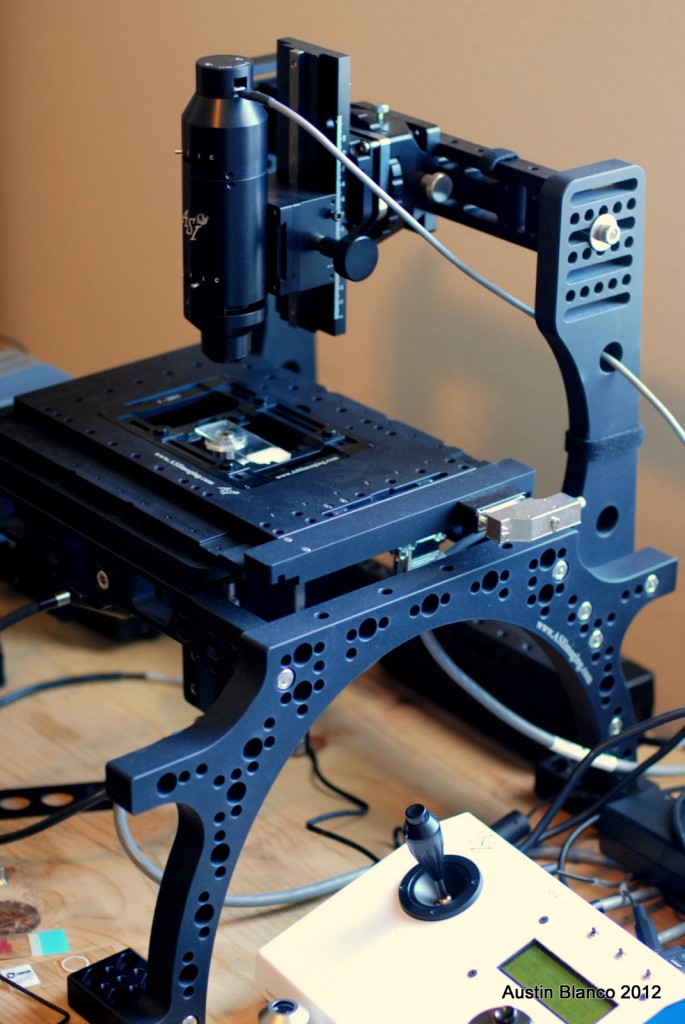 Over the past few years, ASI has cooked up a modular microscope. The design was for an optical bench that would support a wide range of configurations, as well as rapid adaptation and expansion. The system relies on conventional lenses, thus you can use any high quality Leica, Zeiss Nikon or Olympus objective. Just attach the appropriate nosepiece and tube lens, provide an objective, and image away. Of course the first thing one might wonder with a system like this is, how well does it perform? As a complete opto-imaging geek, I’ve been drooling over the opportunity to get my hands on one of these rigs. Luckily, ASI allowed me to borrow one. I decided to build up a complete fluorescent package, in order to truly characterize the system’s performance. Here’s what I found:
Over the past few years, ASI has cooked up a modular microscope. The design was for an optical bench that would support a wide range of configurations, as well as rapid adaptation and expansion. The system relies on conventional lenses, thus you can use any high quality Leica, Zeiss Nikon or Olympus objective. Just attach the appropriate nosepiece and tube lens, provide an objective, and image away. Of course the first thing one might wonder with a system like this is, how well does it perform? As a complete opto-imaging geek, I’ve been drooling over the opportunity to get my hands on one of these rigs. Luckily, ASI allowed me to borrow one. I decided to build up a complete fluorescent package, in order to truly characterize the system’s performance. Here’s what I found:
System Configuration
I built my RAMM variant around the following components:
- RAMM Scope Body with transmitted illuminator.
- Nikon Standard Tube Lens
- Nikon CFI 60 Plan Apo 60x VC 1.4NA Oil Lens
- Chroma Filter Set (Old non-ET set – just what I had handy)
- ASI MS-2000 XYZ Stage and focus block
- ASI CRISP attachment (Not reviewed here)
- Andor Clara Camera
- Lumencor Spectra X Engine
- MicroManager and NIS Elements Software
Design
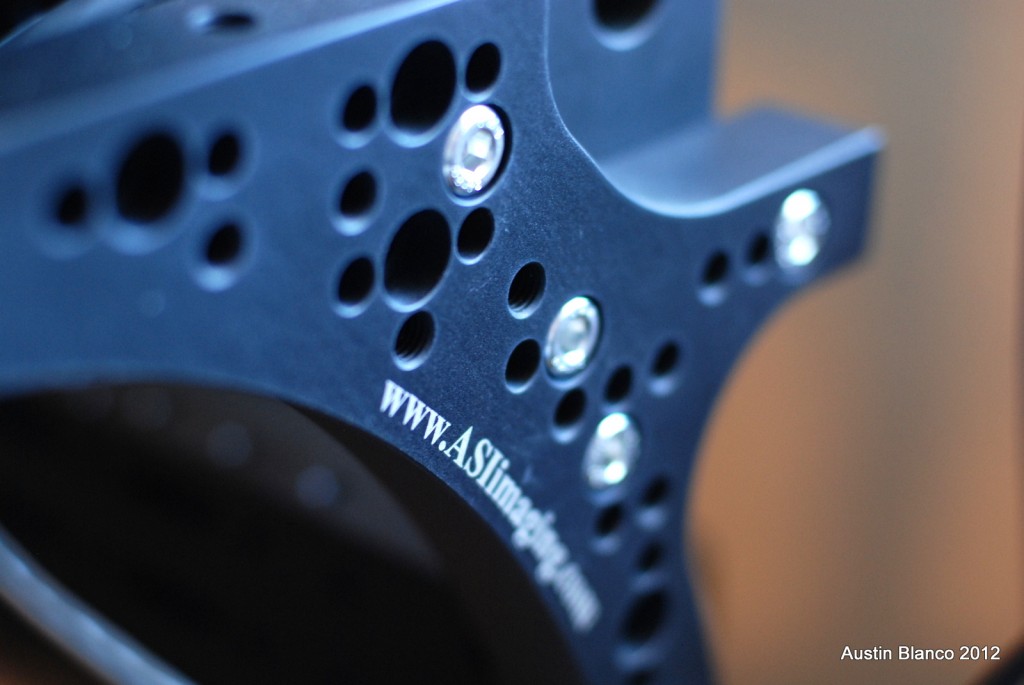 The RAMM is built like a skeleton structure, and looks completely foreign compared to the “normal microscope”. There are attach points drilled all over the body of the stand. I’m assuming some of this is to lighten the body, and also to provide mounting points for new as-yet unknown applications in the future. The entire stand is machined from billet aluminum, and class 2 anodized in black. The different components that make up the base are totally modular.
The RAMM is built like a skeleton structure, and looks completely foreign compared to the “normal microscope”. There are attach points drilled all over the body of the stand. I’m assuming some of this is to lighten the body, and also to provide mounting points for new as-yet unknown applications in the future. The entire stand is machined from billet aluminum, and class 2 anodized in black. The different components that make up the base are totally modular. 
For instance, you can mount the optical system to the top, the bottom, left side or right side of the stand, as may be needed for fit or for custom applications. There is a provision to stack optical paths in the infinity space behind the lens, which allows for the addition of multiple illuminators, or the attachment of additional cameras, CRISP auto-focusing modules, etc. I could also imagine using this port for delivering home-brew laser light, or delivering light from a micropoint or mosaic style of system.
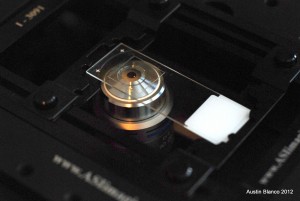 Testing
Testing
Considering that this design is relying on well-characterized optics, I was interested in testing what, if any, errors were introduced by this stand. My first test sample was a Molecular Probes stained kidney section. Z stacks were acquired at 2um spacing with the camera set to full resolution. Results were as expected. Z section images, projections, and 3 dimensional renderings looked as they do on a conventional scope.
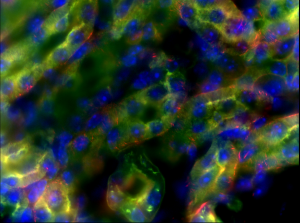
My next sample was much more rigorous. I have a 100nm Tetra-speck bead slide that’s about 10 years old. This meant the fluorescent signal would be very low, but I wanted to acquire some bead stacks to look at basic aberrations or other errors. After taking 20nm sections, I was able to get the following results.
Image Stack from RAMM Scope from austin blanco on Vimeo.
This example shows a nice barely resolvable bead, looking as it should.
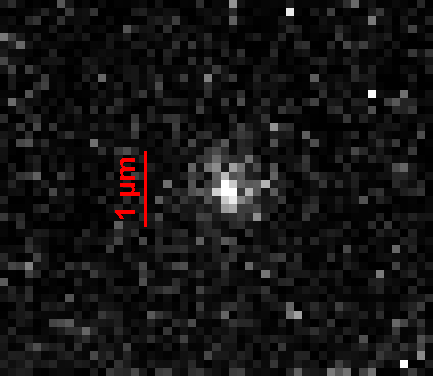
A better representation of a small bead is to view the PSF. Here’s an XY, XZ, YZ Ortho projection showing all 3 sides of the stack. This is a good PSF, as no skew, coma or aberrations are visible. The bead simply looks like an egg. This image is very low signal to noise, so a more robust test is needed to fully characterize the optical system, but in the short term, this shows excellent optical performance for a diffraction limited spot.
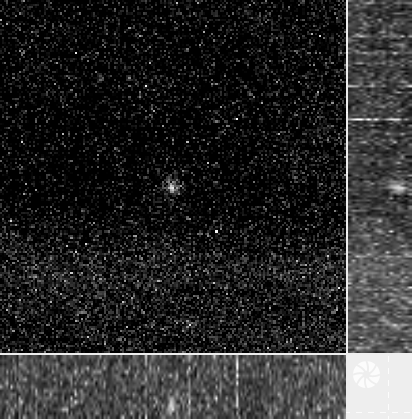
Next I tested stage flatness, with no major problems found across the travel of the stage. Small variations in leveling can be corrected using the insert adjustment screws if needed, which is the same for traditional microscopes.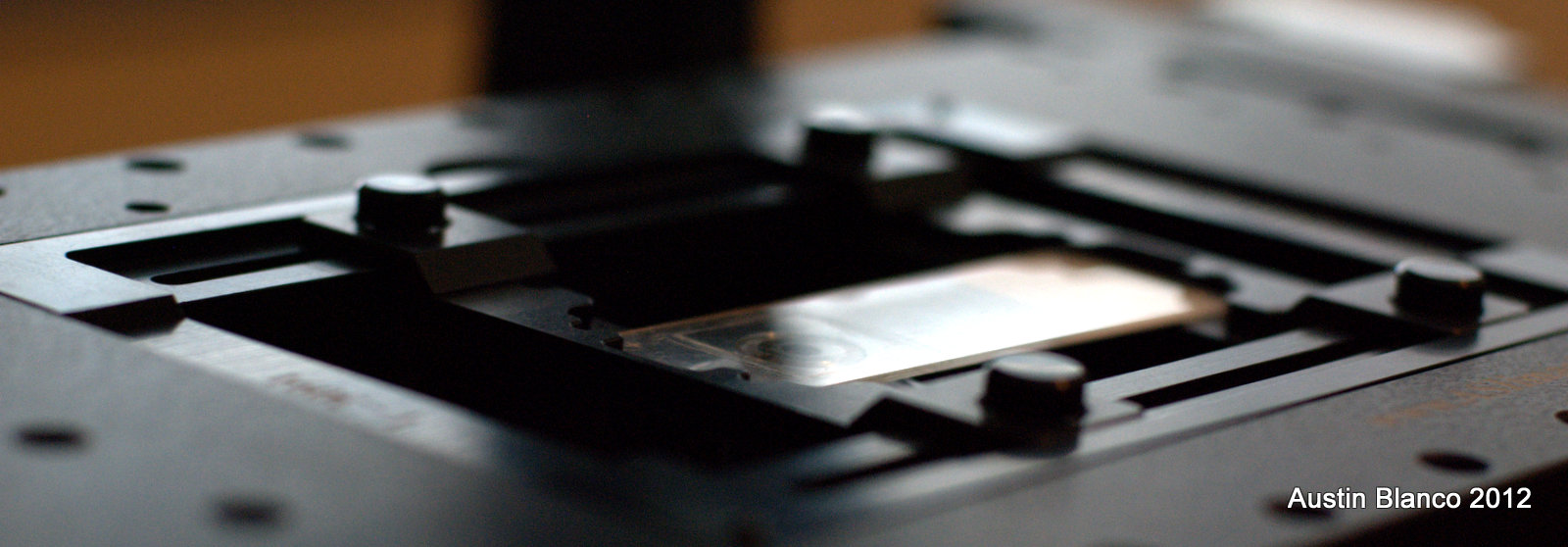
Software Integration
Getting the system configured for use in any software package is rather straightforward, as NIS Elements, and Micro-Manager both support ASI products. Current versions of Micro-Manager have a bug with the Spectra X (all other models are supported though), so in order to test my system I used elements. Both packages run the Andor Clara, as well as most other third party products. I can imagine using this scope for anything from a basic multi-d timelapse rig (building a chamber for this would be cake!) to using it as a spinning disk platform. MetaMorph software would be another great driver for the scope, as Meta is brand-free, and is extremely fast. I’m not sure if all packages have added ASI’s Transmitted LED control yet, but in the worst case one could manually control the brightness, and use the ASI ttl to control the shuttering, providing a low cost and effective transmitted light option.
Limitations
Current limitations include a lack of motorized objective turret for Nikon lenses, (Olympus nosepieces are available) a lack of a multi-position dichroic, and a lack of DIC capability in the design (not to say that DIC isn’t possible, just not “built in”). Of course, the user has to be comfortable running an instrument like this without oculars, but I might be able to convince the most stubborn eye-ball happy microscopist to avoid this if we surveyed how many core facility managers wear glasses…
Advantages
I see several unique and major advantages that one may consider when looking at how a system like this fits into the microscope market:
- The open architecture frame supports all lenses, so you can simply use lenses from your current, maybe outdated or no longer needed scope, without having to invest in a whole new optical line. It also means that users who wish to modify, hack or expand an instrument like this can obtain information from a local company, without having to chew through several layers of red tape. This to me is a major advantage when compared to a traditional big 4 scope.
- The fear of getting stuck with one set of glass is removed. Currently if you invest in a Nikon system, or Zeiss or any other, there is a tendency to keep using that brand, due to the common glass. This system removes that limitation, allowing users to purchase the best objective available, not the best objective for a specific brand.
- The modularity of the instrument translates into major growth potential, as well as refitting for emerging technologies. One could use this initially as a multi-well timelapse scope, them convert it into a TIRF system later on. You can even convert this into an upright!
- The cost of this instrument, when outfitted for motorized acquisition, is $10-20k lower than competing products. This is a compelling point considering how we all have to do more with less these days.
- This instrument occupies 30-50% of the footprint space when compared to traditional inverts. Bench space is always a precious thing in the lab, and this system takes up little. Not only is the width and height less of a problem, but the most common obstacle, the length, is a complete non-issue. The body stands roughly 1.5’x1.5′ in size. consider a typical inverted microscope is something like 2.5′ long! This opens up a new realm of places to stash the scope, saving bench space for the hard science.
Conclusions
I’m very intrigued by this instrument. I think it may have come along at just the right time. Researchers are now realizing that the current product offerings limit the potential for new technologies. Why buy the next model scope, when you can simply expand a well designed system? It’s also a refreshing thought that I can call up ASI, and get all the information I need to leverage this system’s capability. Try that with emailing to Germany or Japan. As budgets tighten, labs need to have more flexible tools. This system provides just that. Of course there will always be a need for a “standard scope”, but for high end, custom applications, this microscope provides a compelling option when compared to the restricted access one must accept when buying a traditional stand. Is our community ready for next-gen optical platforms? Only the future will tell…
Comments
6 responses to “ASI RAMM Microsocpe Testing”
Thank you very much for this very nicely done review!
We are currently considering the ASI RAMM for deconvolution microscopy and I have not decided yet what kind of z-drive is best suited for z-stacks, DC motor or piezo. I was wondering which z-drive you have used for the 20 nm sections? The images look really neat.
Thanks, Chris
Chris
I did not realize that the stage you have tested already has a z-drive, my bad. The 20 nm step size with the DC-motor is impressive. I had thought this could only be achieved by piezo drives.
Hi Chris,
This system uses a rotary encoded Z axis which is accurate to 22nm. So while I told it to step at 20, it was likely 10% inaccurate – OTOH at such a low native axial resolution you won’t see this error, as it’s far below the objective’s resolution!
As to your question of Z stacks, it depends on your needs. For instance if you will cover a large XY area, and you want to slice at 2x the objective’s axial resolution or so, then a DC Z motor is fine. If you want to sample at super fine steps in Z, and repeatability and speed are more important than overall range, then the piezo is better. Now – more often than not if you have nothing, i’d suggest the DC motor first – the reason being is that even with a 300nm pifoc, you’ll be refocusing the standard (assumed manual) focus knob to account for sample container changes or stage level or other changes to the sample distance from the objective over large distances in XY, and it just becomes a pain in the butt to use this type of system. OTOH if your scope already has a focusing setup, then adding the pifoc is fine as you can usually set the pifoc to the middle of it’s range, use the coarse DC system to focus on the moddle of a cell or area to image, and then acquire using the pifoc for fine and fast stepping. Anyways hope my rambling response in some way conveys the pluses and minuses of each option. Thanks for reading!
Yes, it does make a lot of sense. If we decide for the RAMM system, we will go with the DC z-drive. Piezo is quite pricey and the DC with a rotary encoder should be enough for 200 nm (or even 100nm) slices, as I think you suggested.
Another issue is that the MIM module does not come with a motorized filter changer.
A company over here in Germany suggested using an LED light source where each of the LEDs can selectively switched on (an with individual excitation filters if needed) and a Quadband dichroic/emission filter from Semrock.
This would be nice for in vivo work where speed is an issue, but for fixed sample preparation I am not sure. For our fixed samples I would assume we would be best off with single band filter combinations (to avoid bleedthrough and for highest sensitivity).
I will have to talk to the distributor here in Germany if a motorized filter whell on the RAMM is possible.
Cheers
Hi Chris,
ASI Has filter wheels which can be attached before your camera. I’d suggest a Lumencor Spectra for excitaiton, as using a specific wave engine provides you with filter selection, attenuation and shuttering in one package, with a long lifetime as well. My example system used this light engine. I have a review on my site if you search for “light source shootout” you’ll see how it stacks up against conventional sources. So – best scenario would be specific excitation light engine + semrock quad dichroic + single channel emission filters mounted before the camera. This will provide high speed and specificity for single channel imaging.
Good luck on your build!
-Austin
[…] a complete microscope from one control box, on a scalable build platform, at a competitive price. I reviewed the RAMM scope a few years back, and happy to see that the quality and options have only increased over time. When I reviewed the […]